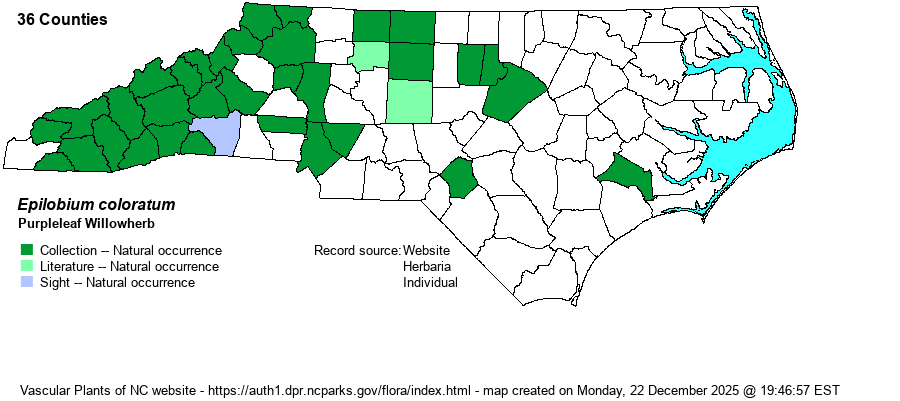| Author | Biehler | |
| Distribution | Throughout the Mountains; present across the upper Piedmont, but sparsely distributed over the central and eastern portions. Only two known records for the Coastal Plain (Jones and Hoke counties, the latter a peaty bog on Fort Bragg).
This is a Northern species, ranging across eastern Canada and south through VA, and south to central NC, northern GA, and AR. | |
| Abundance | Fairly common to frequent in the Mountains; rare to uncommon in the Piedmont foothills, and very rare in the central and eastern portions. Casual in the Coastal Plain and essentially absent there. The NCNHP's State Rank of S3 is too conservative; the website editors give a rank of S3S4 -- to distinguish the abundance levels between it and the two rare Epilobium in the state. | |
| Habitat | This is a wetland species, growing in seepages along roadbanks and rock outcrops, in marshes, ditches, along stream margins, and in other damp ground, usually where sunny. | |
| Phenology | Blooms from June to September, and fruits shortly after flowering. | |
| Identification | This is a fairly slender erect herb, growing to 1.5-2 feet tall, usually with several branches. The stem leaves are scattered and alternate, narrowly lanceolate, about 3-4 inches long but barely 1/4-inch wide near the base, but with a few scattered but obvious teeth. The leaves have a short petiole. From many of the upper leaf axils grow the small flowers, pink to white, with 4 petals, but only about 1/5-inch long. Each flower is on a long and leafy stalk, well away from the stem or branches, such that in bloom the plant looks rather "bushy". The capsules are about 1.5 inches long and very slender, looking like green needles. The three Epilobium species in NC will likely be difficult for biologists to identify even to genus without flowers or fruit, though experienced observers will recognize the genus by their lanceolate leaves with small spiny teeth. E. ciliatum is quite similar, but that species has the larger leaves no more than about 2 inches long, with teeth barely visible, and the tip being acute and not long acuminate as in E. coloratum. Also, that species is mostly unbranched or sparsely so, whereas E. coloratum is normally widely branched and appears "bushy". Weakley (2018) gives a few more differences, but note that E. ciliatum is quite rare in NC. E. leptophyllum has leaves that are linear or nearly so, widest near the middle, with revolute margins, and not toothed along the margins. All three species occur in montane wetlands, but you are much more likely to encounter E. coloratum well before finding the other two, especially as the others are rare and often limited to bogs and other places on private land. | |
| Taxonomic Comments | None
| |
| Other Common Name(s) | Bronze Willowherb, Eastern Willowherb | |
| State Rank | S3 [S3S4] | |
| Global Rank | G5 | |
| State Status | | |
| US Status | | |
| USACE-agcp | OBL link |
| USACE-emp | FACW link |

